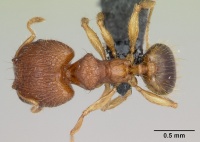Pheidole parva
| Pheidole parva | |
|---|---|

| |
| Scientific classification | |
| Kingdom: | Animalia |
| Phylum: | Arthropoda |
| Class: | Insecta |
| Order: | Hymenoptera |
| Family: | Formicidae |
| Subfamily: | Myrmicinae |
| Tribe: | Attini |
| Genus: | Pheidole |
| Species: | P. parva |
| Binomial name | |
| Pheidole parva Mayr, 1865 | |
| Synonyms | |
| |
| Common Name | |
|---|---|
| Bugi-oozu-ari | |
| Language: | Japanese |
| Notes: | as Pheidole bugi |
Fischer and Fisher (2013) - Pheidole parva is a widespread and probably invasive species in parts of the Old World and belongs to the P. rinae complex (Eguchi et al. 2007). Most likely it is an introduced species to the Malagasy region. Indeed, live ants of this species have recently been found travelling onboard different ships (K. Eguchi, personal communication). Also its ubiquity in many different habitats and microhabitats on Mauritius and the Seychelles and its presence in ports there indicate that it is well-adapted to human environments and thus a likely candidate to invade new areas through human commerce. This tiny and relatively inconspicuous ant is very common in places and can be found in soil and leaf litter, under stones or root mats, in rotten logs, foraging on or nesting in the ground, as well as in lower vegetation and even under the bark of live trees. It was collected in a variety of different habitats, from parks and gardens, to mangrove and coastal scrub, to degraded dry forest, littoral and mixed forest, and rainforest, in elevations between 1 and 445 m. Recently it was also found on the Arabian Peninsula in Saudi Arabia and in the United Arab Emirates, on farms mostly inland from the coast at elevations of 675 and 735 m. As the nests were also found under potted plants, it is very likely that P. parva has been introduced to the Arabian Peninsula by human commerce. Eguchi (2008) - This species prefers open lands, tillage and gardens to woody habitats, and nests under the ground. In rural areas of N. Vietnamese this species and Pheidole yeensis are the most dominant Pheidole species.
| At a Glance | • Invasive |
Identification
Fischer and Fisher (2013) - Small species (WL major 0.73–0.84 mm, WL minor 0.52–0.63 mm) with both worker castes prominently sculptured, promesonotal process absent or inconspicuous, scapes and legs of minor workers short (SI 85–93, FI 91–96), scapes and legs of major workers moderately short (SI 47–51, FI 63–68). Major head rectangular (CI 88–93) with broadly V-shaped posterior emargination, frontal carinae very short or inconspicuous, scrobe weakly developed, submedian hypostomal teeth large, median process present, promesonotum high-domed, strongly convex in profile, spines short-triangular (PSLI 12–16), metatibia with decumbent pilosity and longer erect hairs along outer edge. Minor head subrectangular, punctate, often overlain with rugoreticulate sculpture, scapes, when laid back, not reaching or barely surpassing beyond posterior head margin (SI 85–93), mesosoma fully punctate, spines short-spinose, postpetiole distinctly higher than long (DPpI 125–150).
Southwest Indian Ocean
Fischer and Fisher (2013) - On the smaller islands of the Southwest Indian Ocean, P. parva can be superficially confused with Pheidole jonas, especially because the minors are relatively similar in their morphologies. The main characters distinguishing both worker castes of these two species are: the relative length of the postpetiole in both castes (LPpI minors 83–95, LPpI majors 71–89 in P. parva, versus LPpI minors 122–163, LPpI majors 90–126 in P. jonas); the scapes of the workers of P. parva are distinctly shorter than those of P. jonas (SI 85–93 versus SI 102–122); and the heads of majors are distinctly longer than wide (CI 88–93) in P. parva, versus on average as long as wide (CI 95–102) in P. jonas.
Indo-China
Eguchi (2008) - This species is characterized among Indo-Chinese species by the combination of the following features: in the major frontal carina almost absent; in the major hypostoma in the middle with 3 processes (median process is often low, rarely much reduced); in the minor scape exceeding posterior margin of head by less than half length of antennal segment II, or not reaching the posterior margin; in the minor maximal diameter of eye longer than antennal segment X; in the minor dorsal and lateral faces of head and mesosoma punctured; in the major and minor posterior slope of promesonotal dome lacking a conspicuous prominence/mound.
P. parva is most similar to Pheidole rabo Forel. In the minor of the latter, however, scape usually exceeds posterior margin of head by almost the length of antennal segment II, and maximal diameter of eye is almost as long as or a little shorter than antennal segment X.
Keys including this Species
- Key to Pheidole majors and minors of Borneo
- Key to Pheidole majors of Borneo
- Key to Pheidole minors of Borneo
- Key to Pheidole of the islands of the Southwest Indian Ocean
- Key to the Pheidole of North Vietnam
Distribution
Widely distributed in the Oriental region, Austro-Malayan subregion and W. Pacific.
Latitudinal Distribution Pattern
Latitudinal Range: 32.3753° to -25.3833°.
| North Temperate |
North Subtropical |
Tropical | South Subtropical |
South Temperate |
- Source: AntMaps
Distribution based on Regional Taxon Lists
Afrotropical Region: Saudi Arabia, United Arab Emirates.
Indo-Australian Region: Borneo, Indonesia, Malaysia, Philippines, Singapore.
Malagasy Region: Mauritius, Seychelles.
Oriental Region: India, Myanmar, Nepal, Sri Lanka (type locality), Taiwan, Thailand, Vietnam.
Palaearctic Region: China, Japan, Oman.
Distribution based on AntMaps
Distribution based on AntWeb specimens
Check data from AntWeb
Countries Occupied
| Number of countries occupied by this species based on AntWiki Regional Taxon Lists. In general, fewer countries occupied indicates a narrower range, while more countries indicates a more widespread species. |

|
Estimated Abundance
| Relative abundance based on number of AntMaps records per species (this species within the purple bar). Fewer records (to the left) indicates a less abundant/encountered species while more records (to the right) indicates more abundant/encountered species. |

|
Biology
Sharaf et al (2018) - Oman: found nesting in moist soil under a rock next to a date palm tree. It was also collected from wet leaf litter under a date palm tree. Pheidole parva was also observed inhabiting leaf litter in well-irrigated public parks.
Castes
Worker
Images from AntWeb
   
| |
| Worker. Specimen code casent0055998. Photographer April Nobile, uploaded by California Academy of Sciences. | Owned by CAS, San Francisco, CA, USA. |
   
| |
| Worker. Specimen code casent0133503. Photographer Erin Prado, uploaded by California Academy of Sciences. | Owned by CAS, San Francisco, CA, USA. |
   
| |
| Worker. Specimen code casent0160279. Photographer Estella Ortega, uploaded by California Academy of Sciences. | Owned by CAS, San Francisco, CA, USA. |
   
| |
| Worker (major/soldier). Specimen code casent0160280. Photographer Estella Ortega, uploaded by California Academy of Sciences. | Owned by CAS, San Francisco, CA, USA. |
   
| |
| Worker. Specimen code casent0160528. Photographer Erin Prado, uploaded by California Academy of Sciences. | Owned by CAS, San Francisco, CA, USA. |
   
| |
| Syntype of Pheidole rinae tipuna. Worker. Specimen code casent0904260. Photographer Z. Lieberman, uploaded by California Academy of Sciences. | Owned by MSNG, Genoa, Italy. |
   
| |
| Worker (major/soldier). Specimen code casent0906610. Photographer Estella Ortega, uploaded by California Academy of Sciences. | Owned by NHMW, Vienna, Austria. |
 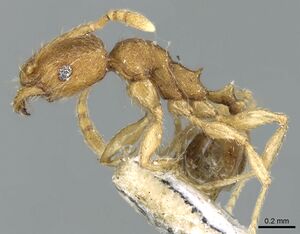  
| |
| Worker. Specimen code casent0906611. Photographer Estella Ortega, uploaded by California Academy of Sciences. | Owned by NHMW, Vienna, Austria. |
   
| |
| Lectotype of Pheidole parva decanica. Worker (major/soldier). Specimen code casent0907985. Photographer Will Ericson, uploaded by California Academy of Sciences. | Owned by MHNG, Geneva, Switzerland. |
   
| |
| Paralectotype of Pheidole parva decanica. Worker. Specimen code casent0907986. Photographer Will Ericson, uploaded by California Academy of Sciences. | Owned by MHNG, Geneva, Switzerland. |
   
| |
| Lectotype of Pheidole rinae mala. Worker (major/soldier). Specimen code casent0907991. Photographer Will Ericson, uploaded by California Academy of Sciences. | Owned by MHNG, Geneva, Switzerland. |
   
| |
| Paralectotype of Pheidole rinae mala. Worker. Specimen code casent0907992. Photographer Will Ericson, uploaded by California Academy of Sciences. | Owned by MHNG, Geneva, Switzerland. |
   
| |
| Lectotype of Pheidole rinae tipuna. Worker (major/soldier). Specimen code casent0907993. Photographer Will Ericson, uploaded by California Academy of Sciences. | Owned by MHNG, Geneva, Switzerland. |
     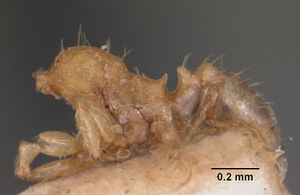 
| |
| Specimen code casent0102292. . | |
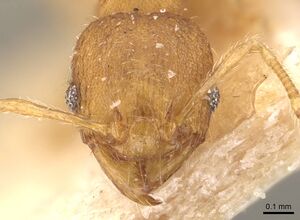 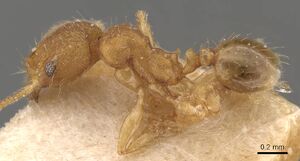  
| |
| Paralectotype of Pheidole rinae tipuna. Worker. Specimen code casent0907994. Photographer Will Ericson, uploaded by California Academy of Sciences. | Owned by MHNG, Geneva, Switzerland. |
Queen
Images from AntWeb
       
| |
| Queen (alate/dealate). Specimen code casent0102293. Photographer April Nobile, uploaded by California Academy of Sciences. | Owned by NHMUK, London, UK. |
 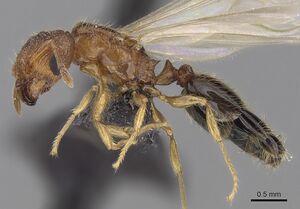   
| |
| Queen (alate/dealate). Specimen code casent0160637. Photographer Estella Ortega, uploaded by California Academy of Sciences. | Owned by CAS, San Francisco, CA, USA. |
    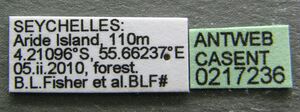
| |
| Queen (alate/dealate). Specimen code casent0217236. Photographer Erin Prado, uploaded by California Academy of Sciences. | Owned by CAS, San Francisco, CA, USA. |
Male
Images from AntWeb
    
| |
| Male (alate). Specimen code casent0160641. Photographer Erin Prado, uploaded by California Academy of Sciences. | Owned by CAS, San Francisco, CA, USA. |
Nomenclature
The following information is derived from Barry Bolton's Online Catalogue of the Ants of the World.
- parva. Pheidole parva Mayr, 1865: 98, pl. 4, fig. 28 (s.w.) SRI LANKA. Bingham, 1903: 245 (q.). Senior synonym of bugi, decanica, mala, sauteri, tipuna: Eguchi, Yamane & Zhou, 2007: 262; of farquharensis, tarda: Fischer & Fisher, 2013: 340.
- decanica. Pheidole parva var. decanica Forel, 1902c: 175 (s.), 192 (w.q.m.) INDIA. [Also described as new by Forel, 1902f: 542.] Junior synonym of parva: Eguchi, Yamane & Zhou, 2007: 261.
- sauteri. Pheidole sauteri Wheeler, W.M. 1909d: 334 (s.w.) TAIWAN. Junior synonym of parva: Eguchi, Yamane & Zhou, 2007: 262.
- mala. Pheidole rinae var. mala Forel, 1911b: 205 (s.w.) INDONESIA (Java). Junior synonym of parva: Eguchi, Yamane & Zhou, 2007: 262.
- tipuna. Pheidole rinae r. tipuna Forel, 1912a: 68 (s.w.) TAIWAN. Junior synonym of parva: Eguchi, Yamane & Zhou, 2007: 262.
- bugi. Pheidole bugi Wheeler, W.M. 1919e: 66 (s.w.) BORNEO. Junior synonym of parva: Eguchi, Yamane & Zhou, 2007: 262. See also: Eguchi, 2001b: 37.
- farquharensis. Pheidole flavens var. farquharensis Forel, 1907d: 91 (w.) MADAGASCAR. Junior synonym of parva: Fischer & Fisher, 2013: 340. See also: Wilson, 2003: 419.
- tarda. Pheidole (Pheidole) tardus Donisthorpe, 1947a: 285 (q.) MAURITIUS. Junior synonym of parva: Fischer & Fisher, 2013: 341.
Unless otherwise noted the text for the remainder of this section is reported from the publication that includes the original description.
Description
Worker
Eguchi (2008) - data from Eguchi, Yamane & Zhou 2007: Major - HL 0.96–1.07 mm; HW 0.85–0.92 mm; CI 85–92; SL 0.41–0.45 mm; SI 45–51; FL 0.57–0.62 mm; FI 64–68. Minor - HL 0.43–0.54 mm; HW 0.39–0.50 mm; CI 88–94; SL 0.38–0.46 mm; SI 84–102; FL 0.39–0.48 mm; FI 93–109.
Major - Head in lateral view not or very weakly impressed on vertex; frons to anterior part of vertex longitudinally rugose; posterior part of vertex rusogo-reticulate; dorsal and dorsolateral faces of vertexal lobe reticulate or rusogo-reticulate; frontal carina absent or inconspicuous (present just as weak rugulae); antennal scrobe absent; median longitudinal carina on clypeus absent, or rarely present but weak; hypostoma with median and submedian processes in addition to conspicuous lateral processes; median process often lower than submedian process, or sometimes almost disappearing; submedian processes usually conspicuous; outer surface of mandible (excluding area around the base) smooth or dimly rugose partly, sparsely with (very) short appressed hairs; antenna with a 3-segmented club; maximal diameter of eye longer than antennal segment X. Promesonotal dome in dorsal view rugoso-reticulate or irregularly rugose with interspaces smooth or dimly to distinctly punctured, or punctured weakly; the dome in lateral view at most with an inconspicuous mound on its posterior slope; humerus weakly produced laterad; the dome at the humeri almost as broad as or broader than at the bottom. Petiole much longer than postpetiole (excluding helcium); petiolar node in lateral view relatively high; postpetiole not massive; first gastral tergite weakly rugoso-punctate in its anterior 1/3 or at least around its articulation with postpetiole.
Minor - Dorsum of head punctured and often overlain by weak rugoso-reticulation; preoccipital carina absent or inconspicuous dorsally; median part of clypeus smooth or weakly punctured; median longitudinal carina absent, or present but weak; antenna with a 3-segmented club; scape exceeding posterior margin of head by less than half length of antennal segment II, or not reaching the posterior margin; maximal diameter of eye longer than antennal segment X. Mesosoma punctured; punctuation on dorsum of promesonotal dome often overlain sparsely by weak rugulae; promesonotal dome in lateral view relatively weakly convex, at most with an inconspicuous mound on its posterior slope; humerus in dorso-oblique view very weakly produced; propodeal spine elongate-triangular. Petiole much longer than postpetiole (excluding helcium); postpetiole not massive.
Fischer and Fisher (2013) - Major Measurements (n=8): HW 0.82–0.92 (0.87), HL 0.92–1.05 (0.97), SL 0.41– 0.43 (0.42), MDL 0.48–0.51 (0.50), EL 0.12–0.13 (0.12), WL 0.73–0.84 (0.77), PNH 0.35–0.41 (0.37), PNW 0.45–0.54 (0.48), MNH 0.53–0.58 (0.55), PDH 0.26–0.27 (0.26), PTL 0.24–0.33 (0.28), PPL 0.12–0.16 (0.14), PTH 0.18–0.21 (0.20), PPH 0.12–0.18 (0.16), PTW 0.14–0.15 (0.14), PPW 0.21–0.24 (0.22), PSL 0.11–0.14 (0.12), MFL 0.55–0.60 (0.57), MTL 0.41–0.43 (0.42), CI 88–93 (89), SI 47–51 (49), MDI 54–61 (57), EI 13–15 (14), FI 63–68 (66), PSLI 12–16 (14), LPpI 71–89 (80), DPpI 146–200 (164), PpWI 147–171 (156), PpLI 39–58 (49), PpHI 81–97 (86).
Head distinctly longer than wide (CI 88–90), in full-face view rectangular with subparallel sides, posterior emargination broadly and weakly V-shaped. Mandibles smooth and shiny, moderately long (MDI 49–59). Clypeus smooth, with median carina absent, lateral carinae weak and short. Frontal carinae relatively short or inconspicuous, antennal scrobe weakly defined, posteriorly superficially punctate. Frons longitudinally rugose, interspaces smooth to superficially punctate, sides of head weakly rugoreticulate and punctate, posterior 1/3 of head increasingly irregularly rugoreticulate, with superficially punctate interspaces. Scapes relatively short (SI 47– 51), with decumbent pilosity and few long, erect, standing hairs on outer edge. Submedian hypostomal teeth large, median process conspicuously developed. Promesonotal dome high and strongly convex in profile, promesonotal process absent, posterior declivity convex to weakly angulate, humeri in dorsal view slightly laterally produced. Surface of promesonotum and lateropronotum rugoreticulate and weakly to superficially punctate, remainder of mesosoma weakly to superficially punctate with small, smooth spots. Metanotal groove very narrow, unimpressed, and with absent to superficially developed cross-ribs. Spines relatively short-acute, subtriangular in profile (PSLI 12–16). Metatibia very short (FI 58–65), with decumbent pilosity, on outer edge with additional longer, erect hairs. Postpetiole in profile about as high as long (LPpI 71–89), with small, weakly acute ventral process, in dorsal view wider anteriorly than posteriorly, and about 1.6 times wider than petiole (PpWI 147–171). Petiole and postpetiole smooth to superficially sculptured. Gaster smooth. Several short to moderately long, stiff, standing hairs on dorsal head and body, pilosity short and decumbent. Color orange-brown, legs lighter orange to yellow, gaster darker.
Minor Measurements (n=9): HW 0.43–0.50 (0.46), HL 0.47–0.53 (0.49), SL 0.38– 0.44 (0.40), MDL 0.27–0.33 (0.29), EL 0.09–0.11 (0.10), WL 0.52–0.63 (0.56), PNH 0.21–0.25 (0.22), PNW 0.29– 0.34 (0.31), MNH 0.35–0.43 (0.38), PDH 0.18–0.22 (0.20), PTL 0.17–0.23 (0.20), PPL 0.09–0.10 (0.09), PTH 0.12–0.14 (0.13), PPH 0.10–0.12 (0.10), PTW 0.08–0.10 (0.08), PPW 0.12–0.15 (0.13), PSL 0.07–0.10 (0.08), MFL 0.40–0.47 (0.43), MTL 0.29–0.35 (0.32), CI 91–95 (93), SI 85–93 (88), MDI 61–66 (64), EI 20–23 (21), FI 91–96 (94), PSLI 15–20 (18), LPpI 83–95 (90), DPpI 125–150 (140), PpWI 144–165 (154), PpLI 41–53 (47), PpHI 79–86 (83).
Head subrectangular, slightly longer than wide (CI 91–95), sides convex, posterior head margin weakly concave, occipital carina not visible in full-face view. Mandibles relatively short (MDI 61–66) and smooth. Clypeus smooth, median carina inconspicuous to faintly developed, lateral carinae short and irregular. Face strongly punctate, punctures sometimes aligned into weak irregular rugulae. Scapes very short (SI 85–93), not reaching to or barely surpassing posterior head margin when laid back, with decumbent pilosity and some longer erect hairs along outer edge. Promesonotal outline in lateral view anteriorly flatly convex to subangulate and posteriorly elongated, with bluntly angulate posterior declivity. Metanotal groove narrow, not or shallowly impressed, with weak to superficial cross-ribs, interspaces smooth to superficially sculptured. Pronotum, mesonotum, and propodeum strongly punctate. Propodeal spines acute, short-spinose, in profile bladelike and pointing slightly anteriorly, shorter than distance between their bases (PSLI 15–20). Metafemur short (FI 91–96), metatibia with decumbent pilosity and scattered suberect hairs. Postpetiole without ventral process, lower than petiole (PpHI 80–86), and slightly higher than long (LPpI 83–95), petiole and postpetiole dorsally smooth to superficially punctate, remainder weakly punctate. Gaster smooth and shiny. Most standing hairs suberect, short to slightly longer, and stiff, with several hairs apically split or subapically branched. Color orange, legs lighter orange to yellow, gaster darker.
Type Material
Eguchi (2008):
Syntypes: 1 major & 2 minors, “Ceylon” [= Sri Lanka], Naturhistorisches Museum Wien, Vienna, examined.
Pheidole parva var. decanica. Lectotype: major, “Cochin (Inde) (Rothney)” [India], MHNG, examined; paralectotypes: 2 majors, “Cochin (Inde) (Rothney)” [India], Musee d'Histoire Naturelle Genève, examined; 3 minors, “Kanara XXXI 8 (Aitken)” [India], MHNG, examined; 3 queens, “Belgaum. (Wroughton) XXXII 1c” [India], MHNG, exam- ined; 3 males, “Belgaum (Wroughton) XXXII 1b”, MHNG, examined; specimens from Poona [India] and Ceylon [Sri Lanka] (according to the original description), not examined.
Pheidole bugi. Lectotype: major, “Sarawak, Borneo, R. Thaxter”, Museum of Comparative Zoology cotype-8947, examined.
Pheidole rinae var. mala. Lectotype: major, “Semarang Java (Jacobson)”, MHNG, examined; paralectotypes: 2 majors & 3 minors, “Semarang Java (Jacobson)”, MHNG, examined.
Pheidole rinae r. tipuna. Lectotype: major, “Takao Formose (Sauter) 25” [= Kaoshung, Taiwan], MHNG, examined; paralectotypes: 3 minors, “Takao 25 Formose (Sauter)”, MHNG, examined.
Pheidole sauteri. Syntypes: 3 majors & 19 minors, “Takao, Formosa, H. Sauter” [= Kaoshung, Taiwan], MCZC cotype 20671, examined.
References
- Ashigar, M.A., Ab Majid, A.H. 2021. Morphological reassessments and DNA barcoding of Pheidole rugaticeps Emery and Pheidole decarinata Santschi collected in Nigeria. International Journal of Tropical Insect Science, 421, 403–413 (doi:[https://doi.org/10.1007%2Fs42690-021-00557-w 10.1007/s42690-021-00557-w
]).
- Bingham, C. T. 1903. The fauna of British India, including Ceylon and Burma. Hymenoptera, Vol. II. Ants and Cuckoo-wasps. London: Taylor and Francis, 506 pp. (page 245, queen described)
- Brassard, F., Leong, C.-M., Chan, H.-H., Guénard, B. 2021. High diversity in urban areas: How comprehensive sampling reveals high ant species richness within one of the most urbanized regions of the world. Diversity 13, 358 (doi:10.3390/d13080358).
- Dendup, K.C., Dorji, C., Dhadwal, T., Bharti, H., Pfeiffer, M. 2021. A preliminary checklist of ants from Bhutan. Asian Myrmecology 14, e014005 (doi:10.20362/am.014005).
- Eguchi, K. 2008. A revision of Northern Vietnamese species of the ant genus Pheidole (Insecta: Hymenoptera: Formicidae: Myrmicinae). Zootaxa 1902:1-118.
- Fischer, G. & Fisher, B.L. 2013. A revision of Pheidole Westwood (Hymenoptera: Formicidae) in the islands of the Southwest Indian Ocean and designation of a neotype for the invasive Pheidole megacephala. Zootaxa 3683, 301–356.
- General, D.E.M. 2021. A preliminary checklist of the ants (Hymenoptera: Formicidae) of the Mt. Pantaron Range, Bukidnon Province, Mindanao Island, Philippines. Halteres, 12:4-14 (doi:10.5281/ZENODO.5371745).
- Hasin, S., Tasen, W., Ohashi, M., Boonriam, W., Yamada, A. 2021. Yellow crazy ants (Anoplolepis gracilipes [Smith, F., 1857]: Hymenoptera: Formicidae) threaten community of ground-dwelling arthropods in dry evergreen forests of Thailand. Agriculture and Natural Resources 55: 634-643 (doi:10.34044/j.anres.2021.55.4.14).
- Khachonpisitsak, S., Yamane, S., Sriwichai, P., Jaitrong, W. 2020. An updated checklist of the ants of Thailand (Hymenoptera, Formicidae). ZooKeys 998, 1–182 (doi:10.3897/zookeys.998.54902).
- Mayr, G. 1865. Formicidae. In: Reise der Österreichischen Fregatte "Novara" um die Erde in den Jahren 1857, 1858, 1859. Zoologischer Theil. Bd. II. Abt. 1. Wien: K. Gerold's Sohn, 119 pp. (page 98, pl. 4, fig. 28 soldier, worker described)
- Nooten, S.S., Lee, R.H., Guénard, B. 2021. Evaluating the conservation value of sacred forests for ant taxonomic, functional and phylogenetic diversity in highly degraded landscapes. Biological Conservation 261, 109286 (doi:10.1016/j.biocon.2021.109286).
- Sarnat, E. M., G. Fischer, B. Guenard, and E. P. Economo. 2015. Introduced Pheidole of the world: taxonomy, biology and distribution. Zookeys. 1-109. doi:10.3897/zookeys.543.6050
- Sharaf, M. R. , B. L. Fisher, H. M. Al Dhafer, A. Polaszek and A. S. Aldawood. 2018. Additions to the ant fauna (Hymenoptera: Formicidae) of Oman: an updated list, new records and a description of two new species. Asian Myrmecology. 9:e010004; 1-38. doi:10.20362/am.010004
- Subedi, I.P., Budha, P.B., Bharti, H., Alonso, L. 2020. An updated checklist of Nepalese ants (Hymenoptera, Formicidae). ZooKeys 1006, 99–136 (doi:10.3897/zookeys.1006.58808).
- Wang, W.Y., Soh, E.J.Y., Yong, G.W.J., Wong, M.K.L., Benoit Guénard, Economo, E.P., Yamane, S. 2022. Remarkable diversity in a little red dot: a comprehensive checklist of known ant species in Singapore (Hymenoptera: Formicidae) with notes on ecology and taxonomy. Asian Myrmecology 15: e015006 (doi:10.20362/am.015006).
- Yamane, S., Hosoishi, S. 2020. Identification of the Japanese species of the ant genus Pheidole based on queen characters. Japanese Journal of Entomology 23 (2):37-53.
References based on Global Ant Biodiversity Informatics
- Anh L. N., K. Ogata, and S. Hosoichi. 2010. Ants of agricultural fields in Vietnam (Hymenoptera: Formicidae). Bull. Inst. Trop. Agr., Kyushu Univ. 33: 1-11.
- Chapman, J. W., and Capco, S. R. 1951. Check list of the ants (Hymenoptera: Formicidae) of Asia. Monogr. Inst. Sci. Technol. Manila 1: 1-327
- Dad J. M., S. A. Akbar, H. Bharti, and A. A. Wachkoo. 2019. Community structure and ant species diversity across select sites ofWestern Ghats, India. Acta Ecologica Sinica 39: 219–228.
- Dias R. K. S. 2002. Current knowledge on ants of Sri Lanka. ANeT Newsletter 4: 17- 21.
- Dias R. K. S. 2006. Current taxonomic status of ants (Hymenoptera: Formicidae) in Sri Lanka. The Fauna of Sri Lanka: 43-52. Bambaradeniya, C.N.B. (Editor), 2006. Fauna of Sri Lanka: Status of Taxonomy, Research and Conservation. The World Conservation Union, Colombo, Sri Lanka & Government of Sri Lanka. viii + 308pp.
- Dias R. K. S., K. R. K. A. Kosgamage, and H. A. W. S. Peiris. 2012. The Taxonomy and Conservation Status of Ants (Order: Hymenoptera, Family: Formicidae) in Sri Lanka. In: The National Red List 2012 of Sri Lanka; Conservation Status of the Fauna and Flora. Weerakoon, D.K. & S. Wijesundara Eds., Ministry of Environment, Colombo, Sri Lanka. p11-19.
- Eguchi K. 2001. A revision of the Bornean species of the ant genus Pheidole (Insecta: Hymenoptera: Formicidae: Myrmicinae). Tropics Monograph Series 2: 1-154.
- Eguchi K. 2008. A revision of Northern Vietnamese species of the ant genus Pheidole (Insecta: Hymenoptera: Formicidae: Myrmicinae). Zootaxa 1902: 1-118.
- Eguchi K., S. Yamane, and S.Y. Zho. 2007. Taxonomic revision of the Pheidole rinae Emery complex. Sociobiology 50 (1): 275-284.
- Eguchi K., and S. Yamane. 2003. Species diversity of ants (Hymenoptera, Formicidae) in a lowland rainforest, northwestern Borneo. New Entomol. 52(1,2): 49-59.
- Eguchi K.; Bui T. V.; Yamane S. 2011. Generic synopsis of the Formicidae of Vietnam (Insecta: Hymenoptera), part I Myrmicinae and Pseudomyrmecinae. Zootaxa 2878: 1-61.
- Eguchi, K. 2001. A revision of the Bornean species of the ant genus Pheidole (Insecta: Hymenoptera: Formicidae: Myrmicinae). Tropics Monogr. Ser. 2: 1-154.
- Eguchi, K. 2008. Eguchi, K. 2008. A revision of North Vietnamese species of the ant genus Pheidole. Zootaxa 1902: 1-118.
- Fischer G. & Fisher B. L. 2013. A revision of Pheidole Westwood (Hymenoptera: Formicidae) in the islands of the Southwest Indian Ocean and designation of a neotype for the invasive Pheidole megacephala. Zootaxa 3683: 301-356
- Fontanilla A. M., A. Nakamura, Z. Xu, M. Cao, R. L. Kitching, Y. Tang, and C. J. Burwell. 2019. Taxonomic and functional ant diversity along tropical, subtropical, and subalpine elevational transects in southwest China. Insects 10, 128; doi:10.3390/insects10050128
- Forel A. 1902. Les Formicides de l'Empire des Indes et de Ceylan. Part IX. J. Bombay Nat. Hist. Soc. 14: 520-546.
- Forel A. 1902. Myrmicinae nouveaux de l'Inde et de Ceylan. Rev. Suisse Zool. 10: 165-249.
- Forel A. 1911. Ameisen aus Ceylon, gesammelt von Prof. K. Escherich (einige von Prof. E. Bugnion). Pp. 215-228 in: Escherich, K. Termitenleben auf Ceylon. Jena: Gustav Fischer, xxxii + 262 pp.
- Forel A. 1911. Ameisen aus Java beobachtet und gesammelt von Herrn Edward Jacobson. II. Theil. Notes Leyden Mus. 33: 193-218.
- Forel A. 1912. H. Sauter's Formosa-Ausbeute. Formicidae (Hym.) (Schluss). Entomol. Mitt. 1: 45-61.
- Forel A. 1913. H. Sauter's Formosa-Ausbeute: Formicidae II. Arch. Naturgesch. (A)79(6): 183-202
- Ghosh S. N., S. Sheela, B. G. Kundu, S. Roychowdhury, and R. N. Tiwari. 2006. Insecta: Hymenoptera: Formicidae. Pp. 369-398 in: Alfred, J. R. B. (ed.) 2006. Fauna of Arunachal Pradesh. (Part -2). [State Fauna Series 13.]. New Delhi: Zoological Survey of India, iv + 518 pp.
- Guénard B., and R. R. Dunn. 2012. A checklist of the ants of China. Zootaxa 3558: 1-77.
- Huang Jian-hua, Zhou Shan-yi. 2007. A checklist of family Formicidae of China - Myrmicinae (Part II) (Insecta: Hymenoptera). Journal of Guangxi Normal University : Natural Science Edition 25(1): 91-99.
- Jaitrong W.; Nabhitabhata, J. 2005. A list of known ant species of Thailand. The Thailand Natural History Museum Journal 1(1): 9-54.
- Leong C. M., S. F. Shiao, and B. Guenard. 2017. Ants in the city, a preliminary checklist of Formicidae (Hymenoptera) in Macau, one of the most heavily urbanized regions of the world. Asian Myrmecology 9: e009014.
- Li Z.h. 2006. List of Chinese Insects. Volume 4. Sun Yat-sen University Press
- Mathew R., and R. N. Tiwari. 2000. Insecta: Hymenoptera: Formicidae. Pp. 251-409 in: Director; Zoological Survey of India (ed.) 2000. Fauna of of Meghalaya. Part 7. [State Fauna Series 4.] Insecta 2000. Calcutta: Zoological Survey of India, 621 pp.
- Mezger D., and M. Pfeiffer. 2011. Influence of the arrival of Anoplolepis gracilipes (Hymenoptera: Formicidae) on the composition of an ant community in a clearing in Gunung Mulu National Park, Sarawak, Malaysia. Asian Myrmecology 4: 89-98.
- Narendra A., H. Gibb, and T. M. Ali. 2011. Structure of ant assemblages in Western Ghats, India: role of habitat, disturbance and introduced species. Insect Conservation and diversity 4(2): 132-141.
- Ngoc Anh L., K. Ogata, and S. Hosoishi. 2010. Ants of agricultural fields in Vietnam (Hymenoptera: Formicidae). Bull. Inst. Trop. Agr. Kyushu Univ. 33: 1-11.
- Pfeiffer M.; Mezger, D.; Hosoishi, S.; Bakhtiar, E. Y.; Kohout, R. J. 2011. The Formicidae of Borneo (Insecta: Hymenoptera): a preliminary species list. Asian Myrmecology 4:9-58
- Pfeiffer, M., H. Cheng Tuck, and T. Chong Lay. 2008. Exploring arboreal ant community composition and co-ccurrence patterns in plantations of oil palm Elaeis guineensis in Borneo and Peninsular Malaysia. Ecography 31(1): 21-32.
- Sitthicharoenchai D., and N. Chantarasawat. 2006. Ant species diversity in the establishing area for Advanced Technology Institute at Lai-Nan Sub-district, Wiang Sa district, Nan Province, Thailand. The Natural History Journal of Chulalongkorn University 6(2): 67-74
- Terayama M. 2009. A synopsis of the family Formicidae of Taiwan (Insecta: Hymenoptera). Research Bulletin of Kanto Gakuen University. Liberal Arts 17:81-266.
- Terayama Mamoru. 2009. A synopsis of the family Formicidae of Taiwan (Insecta, Hymenoptera). The Research Bulletin of Kanto Gakuen University 17: 81-266.
- Terayama, M. 2009. A synopsis of the family Formicidae of Taiwan (Insecta; Hymenoptera). The Research Bulletin of Kanto Gakuen University 17: 81-266.
- Wheeler W. M. 1909. Ants of Formosa and the Philippines. Bulletin of the American Museum of Natural History 26: 333-345.
- Wheeler W. M. 1919. The ants of Borneo. Bulletin of the Museum of Comparative Zoology 63:43-147.
- Wheeler W. M. 1929. Ants collected by Professor F. Silvestri in Formosa, the Malay Peninsula and the Philippines. Bollettino del Laboratorio di Zoologia Generale e Agraria della Reale Scuola Superiore d'Agricoltura. Portici 24: 27-64.
- Wheeler W. M. 1930. Formosan ants collected by Dr. R. Takahashi. Proceedings of the New England Zoological Club 11: 93-106.

